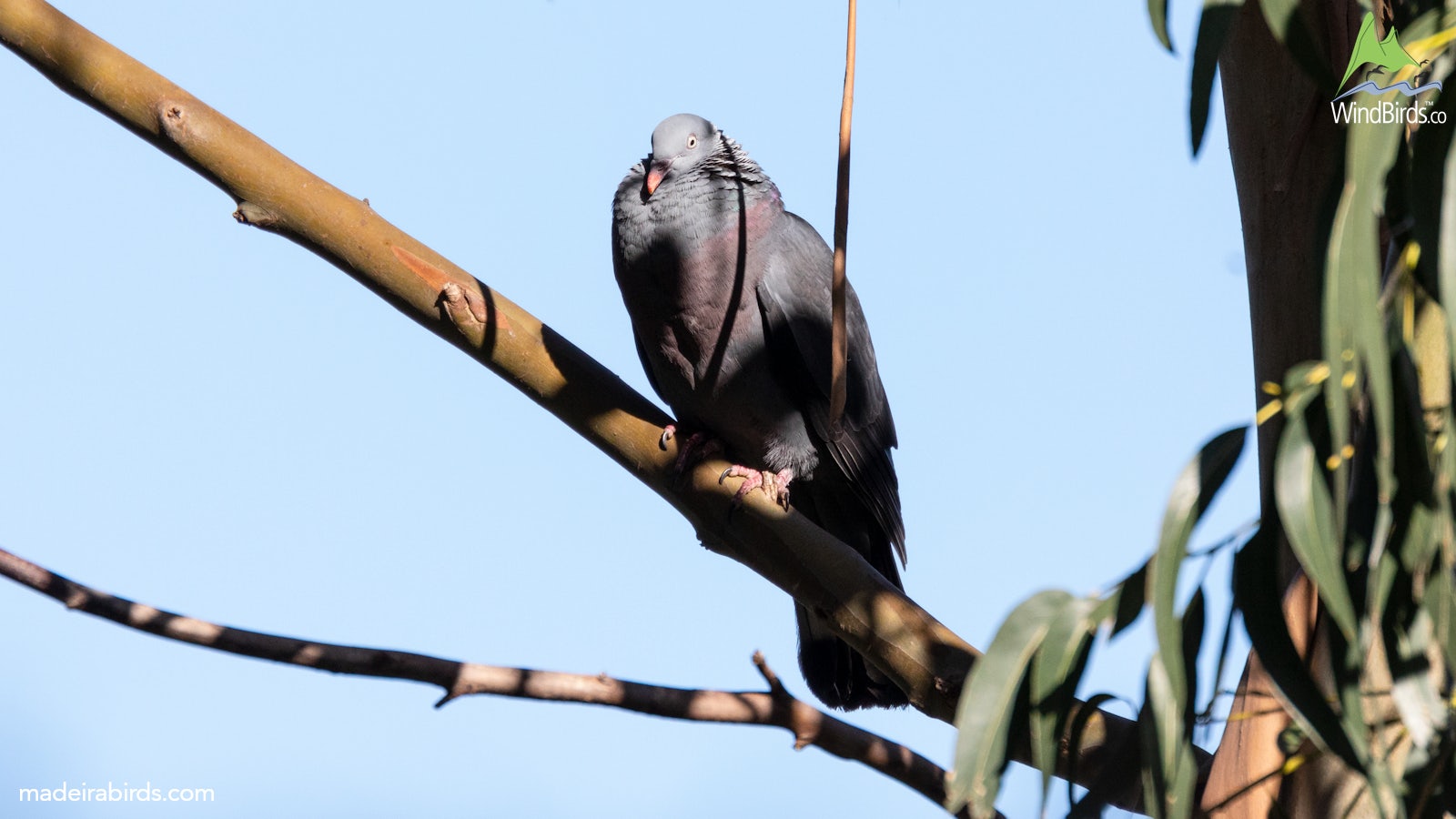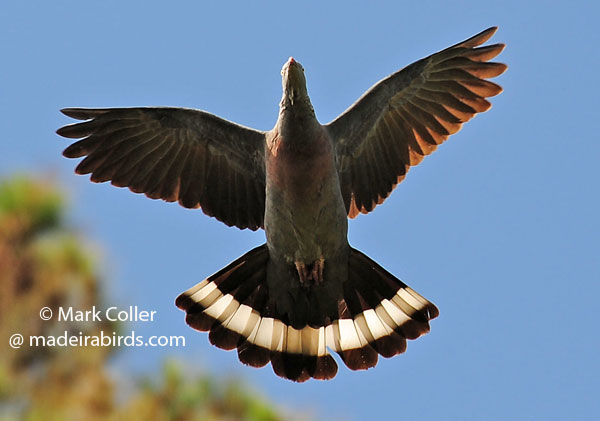Trocaz Pigeon Columba trocaz Heineken, 1829
Order: Columbiformes Family: Columbidae Status: Breeding in Madeira
Recommended birdwatching tours to watch this bird
Half-day birdwatching
Full-day birdwatching
Trocaz Pigeon Field ID Keys
Shape & Size
It is a big though elegant pigeon with long toes. The female is a little smaller than the male but it is not easy to distinguish them.
Colour Pattern
Trocaz Pigeon is dark grey overall with red bill and toes. From a close view, one can observe its stripped silvery patch on its neck-side and its pinkish chest. When flying its white band on the tail and its dark grey underwings, as well as its whole body, are its distinctive features.
Behavior
The Trocaz Pigeon is associated with the Laurel Forest and is very shy as they were affected by shooting and chicks predated by rats.
Habitat
The Madeira Laurel Forest contains almost all of the Trocaz Pigeon's natural food resources though sometimes it is seen in some adjacent agricultural lands, where it looks for cabbages.
Distinction from similar species
In Madeira, there is only the Rock Dove or Feral Pigeon that might be seen together with the Trocaz Pigeon though the bigger size and dark grey colour of the latter is very distinctive.

Columba trocaz Biometrics
Wingspan: 708 - 765 mm (Zino & Zino, 1986)
Total length: 446 - 490 mm (Zino & Zino, 1986)
Weight: 390 - 520 g (Zino & Zino, 1986)
Other Bird Facts
Seasonality in Madeira: All year
Breeding:This Madeira endemic species builds its nest in small and discreet caves on the rocks or sometimes in trees but these are more vulnerable to rain and wind damage. It lays a single egg in one or two annual broods and both parents participate in the incubation and feeding of the chick.
Diet: Feeds on Laurel trees’ berries (Laurus novocanariensis, Ocotea foetens) and on the leaves of several Madeira endemic bushes such as Teline maderensis, Phyllis nobla, Erysimum bicolour between others (Marrero, Oliveira & Nogales, 2004). Outside the Laurel Forest, it mainly eats cabbages.
Status
Madeira local status by Correia-Fagundes et al, 2021: Common breeding bird
Madeira local status by Romano et al, 2010: Common breeding bird
Madeira local status by Zino et al, 1995: Common breeding bird
Conservation status by the IUCN Red List Categories, 2017: Least Concern ver 3.1

Some background on Columba trocaz
Trocaz Pigeon Columba trocaz is an endemic bird of Madeira, first described in 1829 by Heineken, that lives on the northern mountain slopes and in some secluded places of the southern coast of the island where Laurel forest prevails.
The also called Long-toed Pigeon once existed in Porto Santo but nowadays is restricted to Madeira Island. It is highly affected by the destruction of its habitat. This species is not seriously threatened as all Laurel forest areas have been considered Integral or Partial Nature Reserves under the jurisdiction of the Madeira Natural Park - Parque Natural da Madeira.
Although this species is associated with the Laurel forest as it feeds from the berries of the laurel trees and the leaves and flowers (mainly shoots) of other small plants, this large and long-toed pigeon is frequently observed in the cultivated lands near the forest, where it seeks food and usually damages crops, especially cabbages.
For this reason, Trocaz Pigeon became unpopular and was hunted by the population. In 1984 and 1985, the authorities were pressured to authorise the hunting of this species so the farmers could control the damage this pigeons made on their crops. This went on until 1989 when the Trocaz Pigeon population was decreasing significantly and so the species gained a strict protection status.
In 2009, to face the constant complaints of the farmers, the Environment & Natural Resources Board of the Madeira Government - Secretaria Regional do Ambiente e dos Recursos Naturais - officially allowed the Madeira Natural Park to shoot Columba trocaz as a species corrective measure. About 1000 pigeons were killed that year. On the 17th of April 2012, this authorisation was again issued for another year and in 2013 it was again extended until the 17th of April 2014.
During the decades in which these birds were victims of poisoning and killing, the population size was drastically reduced, and some authors say that in 1982 there were only a few more than 500 birds but given the number of birds hunted this estimation rose to over 1000 in 1985 (Zino & Zino, 1986) . After hunting was considered illegal, the first census with a complete and specific methodology was done in 1986 and from the results, it was concluded that there were about 2700 birds. After that, this type of study continued and was done regularly every four years. According to the 1995 census, the population consisted of about 10400 birds, in 1999 more than 8400, in 2003 only 7000 birds and in 2009 between 8500 and 10000 individuals. The Madeira Natural Parks, the institution also in charge of shooting the birds, says to keep doing these censuses but since 2009 the results are not published or are publicly inaccessible.
Name of this species in other languages
Portuguese: Pombo trocaz, Pombo da Madeira
German: Silberhalstaube
Dutch: Trocazduif
Swedish: Madeiraduva
Danish: Madeiradue
Finish: Madeirankyyhky
Norwegian: Madeiradue
Spanish: Paloma de Madeira
French: Pigeon trocaz
Italian: Columba di Madeira
Polish: Golab maderski
Slovak: Holub trokaz
Czech: Holub trokaz
English synonyms: Long-toed pigeon, Madeira Laurel Pigeon
